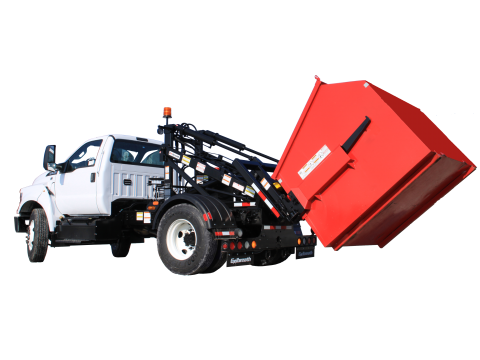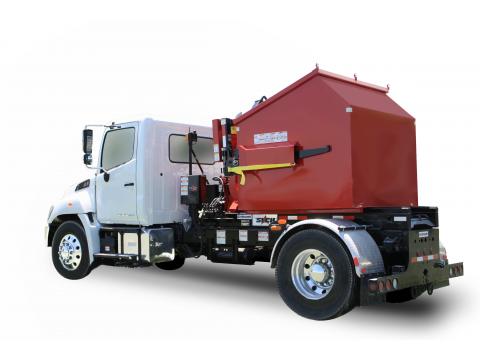Container Handlers for Many Applications
Available in multiple sizes and models, Galbreath® container handlers (or container delivery trailers) are used to move empty or full, front and rear load containers. They are ideal for container delivery, pickup and placement, as well as moving containers around a yard.
Loaded Container Handlers
The Galbreath® Loaded Container Handler (SLCH series) was designed as a safer way to transport front and rear load containers. Containers are designed to sit level during transport to minimize trash spillage. The container and the center of gravity sit in front of the rear axle to maximize weight distribution, allowing safe loaded container transport even at highway speeds.
The rotator mechanism of the Galbreath® SLCH allows dumping of full containers. The product accommodates front load containers up to 10 yards in length, or rear load containers up to 6 yards, with hoist and rotator capacity up to 8,000 lbs. for front load containers.
The design of our load handler for trailers allows smaller trucks to be used for container pickup, making it safer and easier to get into smaller spaces and remote areas. The use of smaller trucks also results in fuel savings and reduced emissions.
Product features include:
- Compatible with both CNG- and diesel-powered engines
- Lower overall height for low overhead clearances
- Container bottom fully supported by dual rails for added safety and stability
- Legal overhang at the rear of the vehicle when hauling loaded containers prevents the need for an ICC bumper
- Ratchet straps to secure containers
- Improved aerodynamic design reduces drag
- Joystick controls inside cab replace lever controls for easy one-hand operation
- Available in eight models - four of those models also feature hydraulically adjusted fork heights for non-ANSI compliant containers
- Options include work lights, fenders, toolboxes, camera kits, pintle hooks, lid holders, platforms for transporting Toter® carts, and more
Unloaded Container Handlers
The Galbreath® unloaded container handler (CH8000 series) is used to move and empty front and rear load containers in a yard. It is available with or without a rotator for emptying loaded containers.
Product features include:
- Ability to handle front load containers 2 – 10 yards in size, and rear load containers 2 – 6 yards in size
- 8,000-lb. capacity with rotating head and with non-rotating head
- Backup alarms and hoist-up alarm with signal light
- Pintle- or Reese-hitch adaptable rear aprons
- Direct-mount pump and oil reservoir
- Inside air controls
- Bumper with recessed LED lighting
- Ratchet straps to secure containers
- Options include work lights, fenders, toolboxes, camera kits, pintle hooks, lid holders, platforms for transporting Toter® carts, and more
Why Choose Galbreath® Container Delivery Units (CDUs)?
- The only manufacturer to have a CDU capable of hauling cans on top of the chassis, making the SLCH products the safest single container-handling, chassis-mounted piece of equipment in the market today
- An engineering staff that is “second to none” when it comes to managing current issues, product support, layouts, weight distribution, research and development, and new product designs based on finite element analysis (FEA)
- Standard engineering layouts for every hoist model, plus custom layouts available to make sure products are compatible with your hoist and chassis specifications
- Quality control programs ensure consistent tolerances and best fit for Galbreath® OEM replacement parts, manufactured components and vendor components
- Full product support offered through customer service, warranty and engineering
- More standard features are built into the product, helping to provide efficient hoist installation and deliver a work-ready solution for the customer
- More optional features allow users to fully equip their products for their unique uses and specifications
- Designed with safety in mind by taking ANSI and DOT (U.S. and Canada) regulations into account

